
- JACQUES-ÉMILE BLANCHE OR THE MUSICAL EYE
- BERNARD BOUTET DE MONVEL OR THE BIRTH OF ART DECO
- GEORGES LEPAPE OR THE ILLUSTRATED WOMAN DURING THE GREAT WAR
- HIPPOLYTUS BLANCARD OR THE AESTHETICS OF A CAPITAL IN RUINS
- MAURICE BOUTET DE MONVEL OR REVELATIONS OF AN ALGERIAN LANDSCAPE
***
JACQUES-ÉMILE BLANCHE OR THE MUSICAL EYE
BY STÉPHANE-JACQUES ADDADE
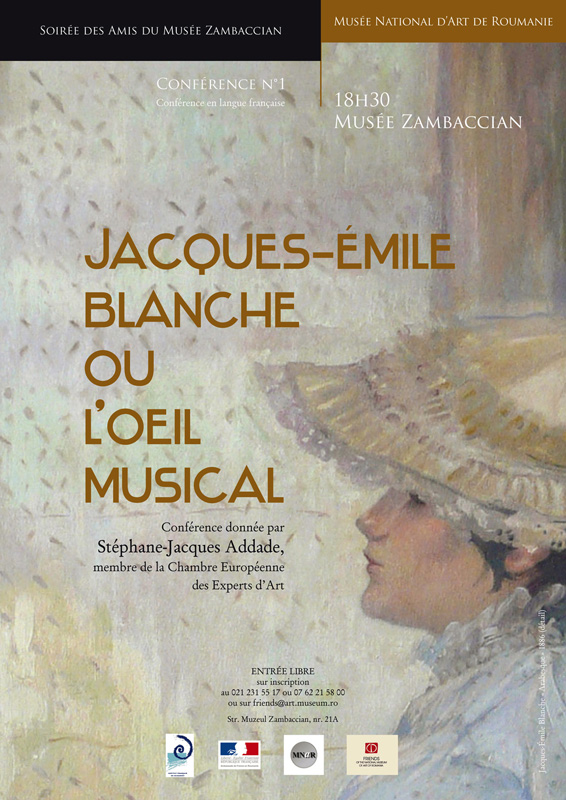 Jacques-Émile BlancheThough painter Jacques-Emile Blanche (1861 - 1942) has remained famous for his countless portraits of the French and English intelligentsia of his time – the very famous effigy of Marcel Proust (1892) was his work for example – what is generally less well known is that he was also an excellent pianist, to the extent that he hesitated between these two careers for a while.
Jacques-Émile BlancheThough painter Jacques-Emile Blanche (1861 - 1942) has remained famous for his countless portraits of the French and English intelligentsia of his time – the very famous effigy of Marcel Proust (1892) was his work for example – what is generally less well known is that he was also an excellent pianist, to the extent that he hesitated between these two careers for a while.
The painter’s passion for music, which initially focused on the work of Richard Wagner - Jacques-Emile Blanche was one of the first subscribers to the Revue Wagnérienne periodical and was to make several pilgrimages to Bayreuth, Germany in 1888 and 1889 – led him to sustain friendships which were to last a lifetime and included musicians such as Gabriel Fauré, Claude Debussy, Igor Stravinsky, as well as Francis Poulenc.... It also coloured a number of his canvasses.
It’s one of these pictures, where painting and music are combined, which is studied in this first lecture. It’s a picture painted in 1886, which was initially supposed to be a “Trial decoration for a music room” in which Jacques-Emile Blanche endeavoured to express his admiration for James Whistler as well as apply Theodor de Wyzewa’s theory about “Peinture wagnérienne” (Wagner’s painting). Later though, it was modified and rechristened by Jacques-Emile Blanche itself, as a tribute to Claude Debussy, after he got to know the composer by intermediary of his great love, soprano Marie-Blanche Vasnier...
***
BERNARD BOUTET DE MONVEL OR THE BIRTH OF ART DECO
BY STÉPHANE-JACQUES ADDADE
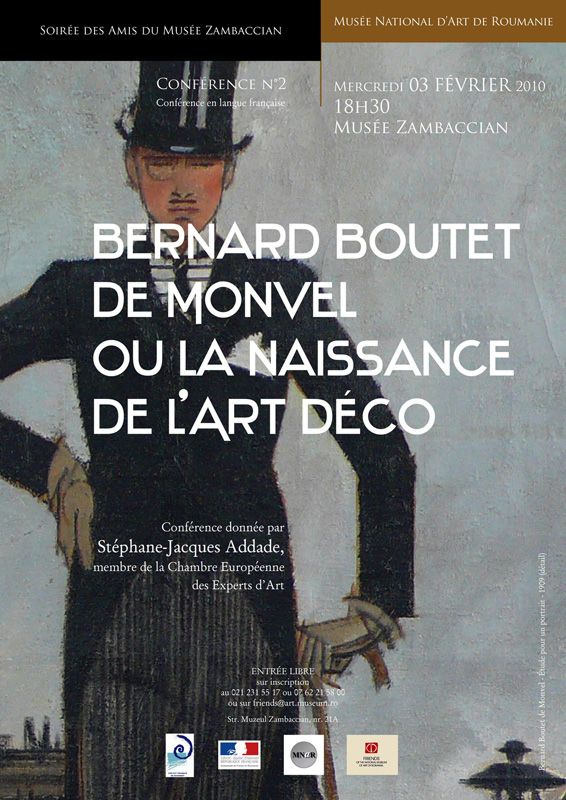 Bernard Boutet de MonvelBernard Boutet de Monvel (1881 - 1949), whom we know today for his Moroccan landscapes painted during the First World War, for the powerful architecture of his precisionist views of New York created at the turn of the 1930s, as well as for some iconic portraits like that of the Maharajah of Indore, was a portraitist of sportsmen and dandies in his early days. However his liking for simplification, imposed on him by colour etching and illustration, like his pioneering interest in a certain form of decorative painting, made him something of a trail-blazer in the Art Deco movement, which is a lesser known fact about him.
Bernard Boutet de MonvelBernard Boutet de Monvel (1881 - 1949), whom we know today for his Moroccan landscapes painted during the First World War, for the powerful architecture of his precisionist views of New York created at the turn of the 1930s, as well as for some iconic portraits like that of the Maharajah of Indore, was a portraitist of sportsmen and dandies in his early days. However his liking for simplification, imposed on him by colour etching and illustration, like his pioneering interest in a certain form of decorative painting, made him something of a trail-blazer in the Art Deco movement, which is a lesser known fact about him.
It’s one of the iconic works – all but forgotten sadly – from the birth of this movement, which this lecture invites us to rediscover and analyse. Indeed Esquisse pour un portrait (Sketch for a portrait), whose deliberately obvious title provided by Bernard Boutet de Monvel was replaced by the more anecdotal Portrait du Comte de Barral (Portrait of the Count of Barral). From the moment the Parisian public cast their eyes on it in 1909, it created a stir and led the way towards a new aesthetic. This new aesthetic was that of a systematic decorative diversion; that of a work based not on a fragmented, split form, according to the proposition made by certain avant-garde, but rather a form which was rigorously structured by geometric synthetism, by the ruler and the compass; that of a work, merging classicism and modernity, a working drawing and monumentality...
***
GEORGES LEPAPE OR THE ILLUSTRATED WOMAN DURING THE GREAT WAR
BY STÉPHANE-JACQUES ADDADE
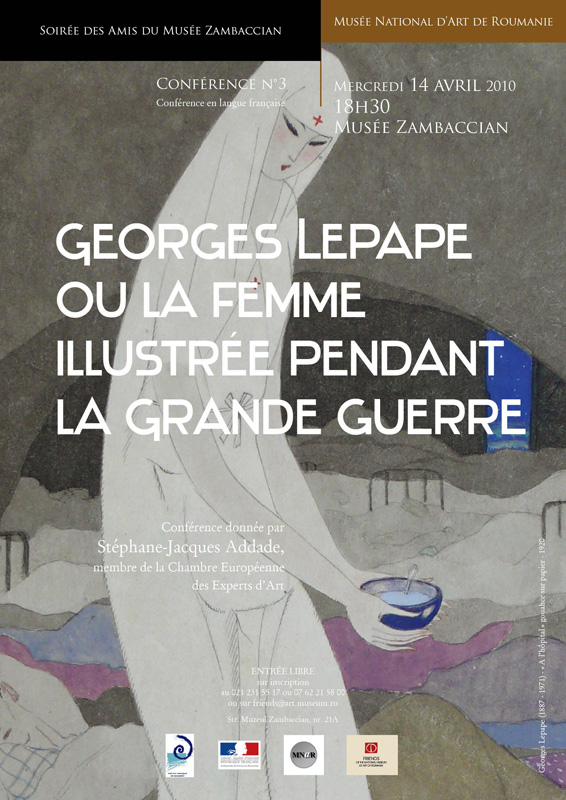 Georges LepapeWomen certainly remain the least celebrated heroines of the First World War. And yet, whether they were factory workers, nurses or simply soldiers' penfriends, their contribution was essential throughout the conflict. The illustrator Georges Lepape (1887 - 1971), whose delicate art retains a definitive attachment to the creations of the fashion designer Paul Poiret, devoted all his talent and a collection of paintings to them. He was the only artist at the time to pay tribute to them.
Georges LepapeWomen certainly remain the least celebrated heroines of the First World War. And yet, whether they were factory workers, nurses or simply soldiers' penfriends, their contribution was essential throughout the conflict. The illustrator Georges Lepape (1887 - 1971), whose delicate art retains a definitive attachment to the creations of the fashion designer Paul Poiret, devoted all his talent and a collection of paintings to them. He was the only artist at the time to pay tribute to them.
It's one of these paintings – one of the most iconic gouaches due to Georges Lepape's brushwork – that we'll discover and decipher during this lecture. That said, it is an opportunity to evoke the refinement of the miniatures of Persia and the implausible vision of the world it develops; the Russian ballets by Serge de Diaghilev, and more especially the influence that the willowy figure of Ida Rubinstein was to exert over art in her time, as well as Paul Poiret, to whom Georges Lepape prophetically pays tribute in the distraught figure of one of the injured soldiers...
***
HIPPOLYTUS BLANCARD OR THE AESTHETICS OF A CAPITAL IN RUINS
BY STÉPHANE-JACQUES ADDADE
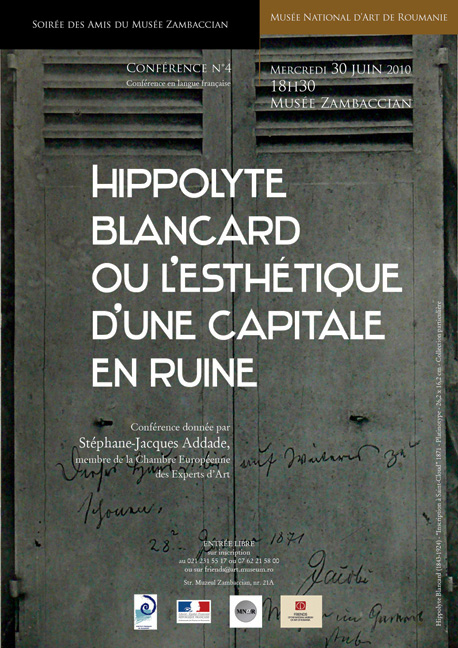 Hippolyte BlancardThe siege of Paris, then the District which immediately followed, were the first events in the history of France to have been prolifically photographed.
Hippolyte BlancardThe siege of Paris, then the District which immediately followed, were the first events in the history of France to have been prolifically photographed.
Immediately after the surrender of their city, on 28 January 1871, a great number of Parisian photographers homed in on it, with the emphasis on Saint Cloud, to witness the destruction caused by the battles against the Prussian army.
In this way, a new genre of offensive was to begin, that of the "artilleurs du collodion" (the collodion gunners). Indeed the vision of this destruction was to stir up incredible infatuation, as much for the artists, who sang the praises of the ancient ruins in the gutted buildings, as for the growing tourist industry, which, like the Cook agency in London, went as far as to organise trips to the ruined Paris for an audience across the Channel...
The study of a surprising platinum print by Hippolytus Blancard, from a negative on glass using dry collodion and depicting the shutters of the Sévin house in Saint Cloud, will enable us to expand on these matters, whilst we wonder about the political range of such a negative.
Moreover this study will enable us to question the influence that such an event, juxtaposing paradoxical elements and combining the verb and the image, could have had on later artistic movements such as surrealism...
***
MAURICE BOUTET DE MONVEL OR REVELATIONS OF AN ALGERIAN LANDSCAPE
BY STÉPHANE-JACQUES ADDADE
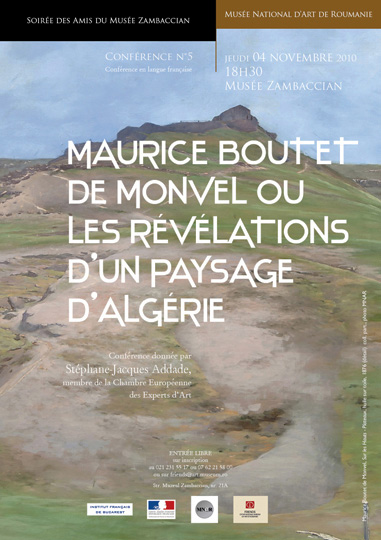 Maurice Boutet de MonvelThe 1870s in France was a period which saw an abundance of pictorial research, now based on a single observation, thanks to the teaching of the Realists. In this way they turned to the explosion of "pleinairisme" (open-airism), which was to push a number of painters to leave their studios to work on motif, light and colours.
Maurice Boutet de MonvelThe 1870s in France was a period which saw an abundance of pictorial research, now based on a single observation, thanks to the teaching of the Realists. In this way they turned to the explosion of "pleinairisme" (open-airism), which was to push a number of painters to leave their studios to work on motif, light and colours.
They also turned to the popularisation of photography, which was becoming an essential tool for their creation.
With Eugène Delacroix crystallising the irresistible appeal of the Orient for French artists, Algeria appeared as one of the preferred places for this quest.
Thanks to the study of a remarkable view of Mansourah, painted in 1876 by Maurice Boutet de Monvel (1850 - 1913) on the High Plateau of Kabylia, which doesn't take up the conventions of the then oriental painting so as to try to justify the pale northerly light, the silence and the emptiness, this lecture will enable these questions to be evoked. In turn this will draw our attention to the romantic design of the landscape, and more particularly the pantheistic and introspective art of Caspar David Friedrich...
Dernière modification par Stéphane-Jacques Addade, le 23/03/2015